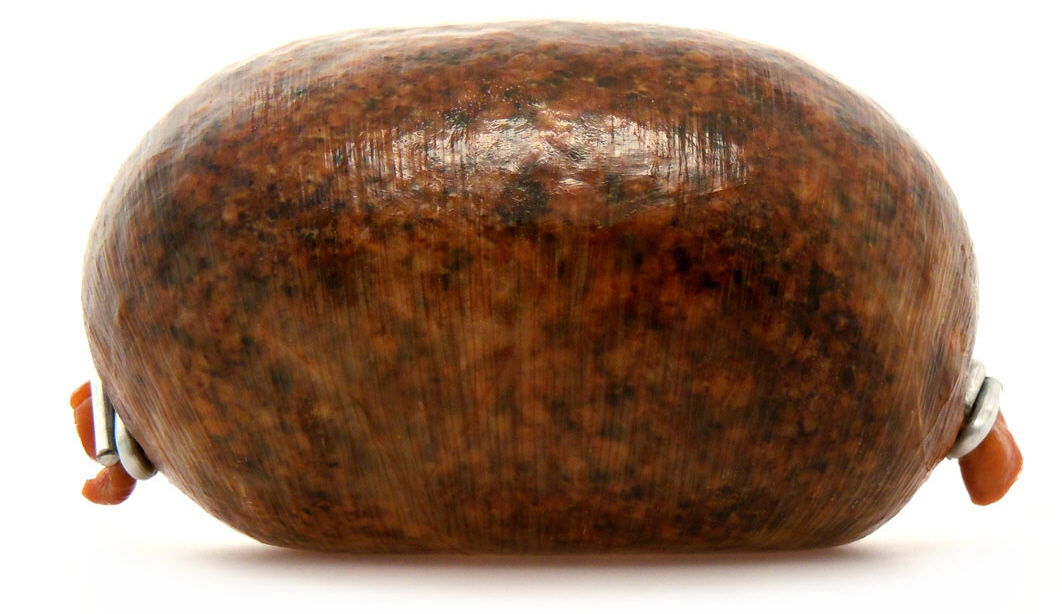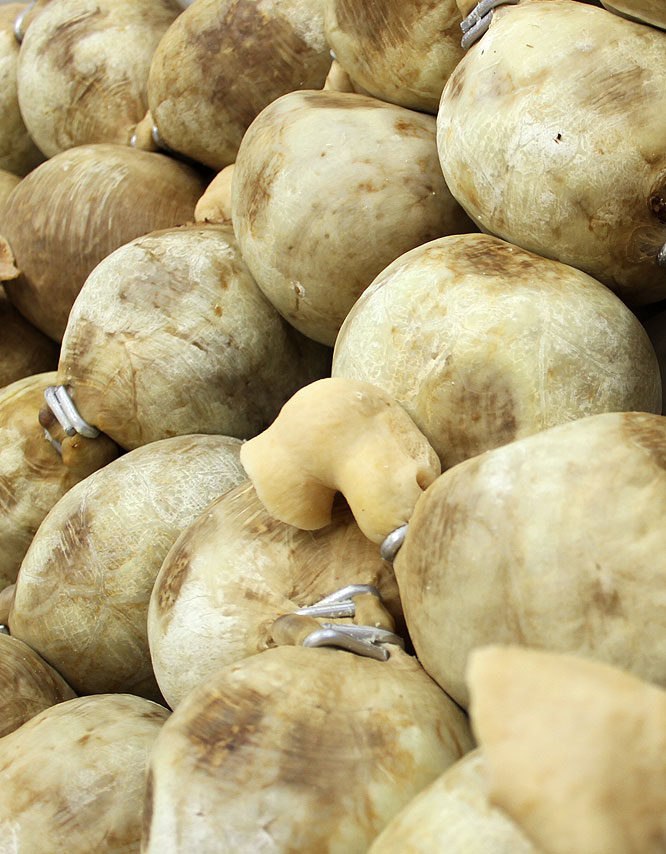

|
 I’ve often wondered about that.” P. G. Wodehouse, ‘Right Ho, Jeeves‘  Lancashire Haggis Image: http://www.lancashirehaggis.co.uk The minced pluck (the heart, lungs (‘lights’), and liver, sometimes with the tripe and chitterlings) of a beast, nowadays usually a sheep but historically a calf, with suet and oatmeal, seasoned with salt, ample pepper, onions, spices (commonly ground coriander seed), boiled like a very large sausage in a skin.  Fine Lancashire Haggis Image: http://www.lancashirehaggis.co.uk Although there are many known old receipts for offal and oatmeal puddings, such as Hackin or Hogs Pudding, the earliest reference to haggis (‘hagese’) is in the Lancashire verse cookbook Liber Cure Cocorum (Liber Cure 1430). This is about 50 years before the first reference in Scotland. It continued to appear in English texts up to the 19th Century, and was clearly as loved or loathed as it is now, for Markham’s ‘English Huswife’ of 1615 has, “That pudding which is called the Haggas or Haggus, of whose goodnesse it is in vain to boast, because there is hardly to be found a man that doth not affect them.”  Original Receipt in the verse cookery book ‘Liber Cure Cocorum‘, North West of Lancashire c1430 (Liber Cure 1430).. Original Receipt in the verse cookery book ‘Liber Cure Cocorum‘, North West of Lancashire c1430 (Liber Cure 1430)..For hagese. Both Rundell 1807 and the vast Victorian cookery reference book, Cassell’s, distinguish between English Haggis, which adds bacon to the minced sheep pluck together with breadcrumb and strong flavourings, and Scottish Haggis which uses beef suet as the fat and oatmeal as the binder with more spicy flavourings of pepper and nutmeg.  Original Receipt in ‘A New System Of Domestic Cookery‘ by ‘A Lady’ (Mrs. Maria Eliza Ketelby Rundell) (Rundell 1807); Original Receipt in ‘A New System Of Domestic Cookery‘ by ‘A Lady’ (Mrs. Maria Eliza Ketelby Rundell) (Rundell 1807); AN ENGLISH HAGGIS. Take the heart, the tongue, and a part of the liver of the sheep, with a third of its weight in fat bacon, two anchovies chopped small, and the crumb of a penny-roll grated, a salt-spoonful of grated lemon-peel, pepper, salt, two eggs beaten, and a glass of wine; mix all well together; butter a mould; put in the mixture, and let it boil for two hours; or it may be boiled in a veal caul.  Original Receipt in ‘The Art of Cookery Made Easy and Refined‘ by John Mollard, 1802 (Mollard 1802) Original Receipt in ‘The Art of Cookery Made Easy and Refined‘ by John Mollard, 1802 (Mollard 1802)TO MAKE HAGGIS. Blanch and chop the heart and lights of a sheep, then add a pound of beef suet chopped very fine, crumbs of French roll soaked in cream, a little beaten cinnamon, mace, cloves, and nutmeg, half a pint of sweet wine, a pound of raisins stoned and chopped, a sufficient quantity of flour to make it of a proper consistence, a little salt, the yolks of three eggs, and some sheep^s chitterlings well cleaned and cut into slips. Mix all together, and have ready a sheep’s bag nicely cleaned, in which put the mixture; then tie it tightly and boil it three hours; or it may be made savory, omitting the wine and the stoned raisins. Earlier Haggis, this one from 1664, may have been a little different..  Original Receipt in ‘TThe cook’s guide: or, Rare receipts for cookery (1664)‘ by Hannah Woolley (Wooley 1664) Original Receipt in ‘TThe cook’s guide: or, Rare receipts for cookery (1664)‘ by Hannah Woolley (Wooley 1664)To make a Haggis Pudding. TAke your Haggis or Calves ginne clean scowred and watered, and parboyl it well; then take out the Kernels, and chop it fine; season it with salt, Sugar and bea ten spice; then put to it a little Cream, and ten or twelve yolks of Eggs, as much gra ted bread, a few minced Dates and plump ed Currans, and so fill your skins, and boyl them carefully. TT Wilkinson’s ‘Lancashire Folklore‘ of 1867 explains how haggis was the favourite food of witches; “The village of Singleton (in the Fylde) is remarkable only for having been the residence of “Mag Shelton,” a famous witch in her day. Her food, we are told, was haggis (at that time commonly used in the district) made of boiled groats, mixed with thyme or parsley.” Although, of course, haggis has a continuing popularity in Scotland, there are several makers in northern England. For Sweet Haggis, see: Hackin See also: Nettle Haggis, Kew Haggis  |
|
MORE FROM Foods of England... Cookbooks ● Diary ● Index ● Magic Menu ● Random ● Really English? ● Timeline ● Donate ● Royalty ● English Service ● Food Map of England ● Lost Foods ● Accompaniments ● Biscuits ● Breads ● Cakes and Scones ● Cheeses ● Classic Meals ● Curry Dishes ● Dairy ● Drinks ● Egg Dishes ● Fish ● Fruit ● Fruits & Vegetables ● Game & Offal ● Meat & Meat Dishes ● Pastries and Pies ● Pot Meals ● Poultry ● Preserves & Jams ● Puddings & Sweets ● Sauces and Spicery ● Sausages ● Scones ● Soups ● Sweets and Toffee ● About ... ● Bookshop ● Email: [email protected] COPYRIGHT and ALL RIGHTS RESERVED: © Glyn Hughes 2022 BUILT WITH WHIMBERRY |